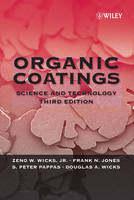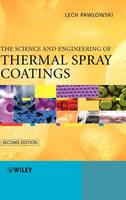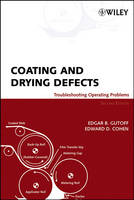Organic Coatings
Organic Coatings
Science and Technology
Jones, Frank N.; Wicks, Zeno W.; Wicks, Douglas A.; Pappas, Socrates Peter
John Wiley and Sons Ltd
02/2007
746
Dura
Inglês
9780471698067
1580
Descrição não disponível.
Preface. Symbols and Units. 1. What Are Coatings? 1.1. Definitions and Scope. 1.2. Composition of Coatings. References. 2. Polymerization and Film Formation. 2.1. Polymers. 2.2. Polymerization. 2.3. Film Formation. General References. References. 3. Flow. 3.1. Shear Flow. 3.2. Types of Shear Flow. 3.3. Determination of Shear Viscosity. 3.4. Shear Viscosity of Resin Solutions. 3.5. Viscosity of Liquids with Dispersed Phases. 3.6. Other Modes of Flow. General References. References. 4. Mechanical Properties. 4.1. Introduction: General Comments on Testing of Coating Films. 4.2. Basic Mechanical Properties. 4.3. Formability and Flexibility. 4.4. Abrasion and Mar Resistance. 4.5. Measurement of Mechanical Properties. 4.6. Tests of Coatings on Substrates. General References. References. 5. Exterior Durability. 5.1. Photoinitiated Oxidative Degradation. 5.2. Photostabilization. 5.3. Degradation of Chlorinated Resins. 5.4. Hydrolytic Degradation. 5.5. Other Modes of Failure on Exterior Exposure. 5.6. Testing for Exterior Durability. General References. References. 6. Adhesion. 6.1. Surface Mechanical Effects on Adhesion. 6.2. Effects of Internal Stress and Fracture Mechanics. 6.3. Relationship Between Wetting and Adhesion. 6.4. Adhesion to Metal Surfaces. 6.5. Adhesion to Plastics and to Coatings. 6.6. Testing for Adhesion. General References. References. 7. Corrosion Protection by Coatings. 7.1. Corrosion of Uncoated Steel. 7.2. Corrosion Protection of Metals. 7.3. Corrosion Protection by Intact Coatings. 7.4. Corrosion Protection by Nonintact Films. 7.5. Evaluation and Testing. General References. References. 8. Acrylic Resins. 8.1. Thermoplastic Acrylic Resins. 8.2. Thermosetting Acrylic Resins. 8.3. Water-Reducible Thermosetting Acrylic Resins. References. 9. Latexes. 9.1. Emulsion Polymerization. 9.2. Acrylic Latexes. 9.3. Vinyl Ester Latexes. 9.4. Thermosetting Latexes. General References. References. 10. Polyester Resins. 10.1. Hydroxy-Terminated Polyester Resins for Conventional Solids Coatings. 10.2. Polyester Resins for High-Solids Coatings. 10.3. Carboxylic Acid Terminated Polyester Resins. 10.4. Carbamate-Functional Polyester Resins. 10.5. Water-Reducible Polyester Resins. 10.6. Polyester Resins for Powder Coatings. References / 211 11. Amino Resins. 11.1. Synthesis of Melamine Formaldehyde Resins. 11.2. Types of MF Resins. 11.3. MF Polyol Reactions in Coatings. 11.4. Other Amino Resins. References. 12. Binders Based on Polyisocyanates: Polyurethanes. 12.1. Reactions of Isocyanates. 12.2. Kinetics of Reactions of Isocyanates with Alcohols. 12.3. Isocyanates Used in Coatings. 12.4. Two Package Solventborne Urethane Coatings. 12.5. Blocked Isocyanates. 12.6. Moisture-Curable Urethane Coatings. 12.7. Waterborne Urethane Coatings. 12.8. Hydroxy-Terminated Polyurethanes. References. 13. Epoxy and Phenolic Resins. 13.1. Epoxy Resins. 13.2. Epoxy Amine Systems. 13.3. Other Cross-Linking Agents for Epoxy Resins. 13.4. Water-Reducible Epoxy Acrylic Graft Copolymers. 13.5. Epoxy Resin Phosphate Esters. 13.6. Phenolic Resins. General References. References. 14. Drying Oils. 14.1. Composition of Natural Oils. 14.2. Autoxidation and Cross-Linking. 14.3. Synthetic and Modified Drying Oils. General References. References. 15. Alkyd Resins. 15.1. Oxidizing Alkyds. 15.2. High-Solids Oxidizing Alkyds. 15.3. Water-Reducible Alkyds. 15.4. Nonoxidizing Alkyds. 15.5. Synthetic Procedures for Alkyd Resins. 15.6. Modified Alkyds. 15.7. Uralkyds and Other Autoxidizable Urethanes. 15.8. Epoxy Esters. General Reference. References. 16. Silicon Derivatives. 16.1. Silicones. 16.2. Reactive Silanes. 16.3. Orthosilicates. References. 17. Other Resins and Cross-Linkers. 17.1. Halogenated Polymers. 17.2. Cellulose Derivatives. 17.3. Unsaturated Polyester Resins. 17.4. (Meth)acrylated Oligomers. 17.5. 2-Hydroxyalkylamide Cross-Linkers. 17.6. Acetoacetate Cross-Linking Systems. 17.7. Polyaziridine Cross-Linkers. 17.8. Polycarbodiimide Cross-Linkers. 17.9. Polycarbonates. References. 18. Solvents. 18.1. Solvent Composition. 18.2. Solubility. 18.3. Solvent Evaporation Rates. 18.4. Viscosity Effects. 18.5. Flammability. 18.6. Other Physical Properties. 18.7. Toxic Hazards. 18.8. Atmospheric Photochemical Effects. 18.9. Regulation of Solvent Emissions from Coatings. General References. References. 19. Color and Appearance. 19.1. Light. 19.2. Light Object Interactions. 19.3. Hiding. 19.4. Metallic and Interference Colors. 19.5. The Observer. 19.6. Interactions of Light Source, Object, and Observer. 19.7. Color Systems. 19.8. Color Mixing. 19.9. Color Matching. 19.10. Gloss. General References. References. 20. Pigments. 20.1. White Pigments. 20.2. Color Pigments. 20.3. Inert Pigments. 20.4. Functional Pigments. 20.5. Nano-pigments. General References. References. 21. Pigment Dispersion. 21.1. Dispersion in Organic Media. 21.2. Formulation of Non-aqueous Mill Bases. 21.3. Dispersions in Aqueous Media. 21.4. Dispersion Equipment and Processes. 21.5. Evaluation of Dispersion. General References. References. 22. Effect of Pigments on Coating Properties. 22.1. PVC and CPVC. 22.2. Relationships Between Film Properties and PVC. References. 23. Application Methods. 23.1. Brushes, Pads, and Hand Rollers. 23.2. Spray Application. 23.3. Dip and Flow Coating. 23.4. Roll Coating. 23.5. Curtain Coating. General References. References. 24. Film Defects. 24.1. Surface Tension. 24.2. Leveling. 24.3. Sagging and Drip Marks. 24.4. Crawling, Cratering, and Related Defects. 24.5. Floating and Flooding; Hammer Finishes. 24.6. Wrinkling and Wrinkle Finishes. 24.7. Bubbling and Popping. 24.8. Foaming. 24.9. Dirt. General References. References. 25. Solventborne and High-Solids Coatings. 25.1. Primers. 25.2. Top Coats. General Reference. References. 26. Waterborne Coatings. 26.1. Water-Reducible Coatings. 26.2. Latex-Based Coatings. 26.3. Emulsion Coatings. General References. References. 27. Electrodeposition Coatings. 27.1. Anionic Electrodeposition Coatings. 27.2. Cationic Electrodeposition Coatings. 27.3. Effect of Variables on Electrodeposition. 27.4. Application of Electrodeposition Coatings. 27.5. Advantages and Limitations of Electrodeposition. 27.6. Autodeposition Coatings. General Reference. References. 28. Powder Coatings. 28.1. Binders for Thermosetting Powder Coatings. 28.2. Binders for Thermoplastic Powder Coatings. 28.3. Formulation of Thermosetting Powder Coatings. 28.4. Manufacture of Powder Coatings. 28.5. Application Methods. 28.6. Advantages and Limitations of Powder Coatings. General References. References. 29. Radiation Cure Coatings. 29.1. UV Curing. 29.2. Free Radical Initiated UV Cure. 29.3. Cationic UV Cure. 29.4. Effects of Pigmentation. 29.5. Electron Beam Cure Coatings. 29.6. Dual UV/Thermal Cure and Selected Applications. 29.7. Advantages and Limitations. General References. References. 30. Product Coatings for Metal Substrates. 30.1. OEM Automotive Coatings. 30.2. Appliance Coatings. 30.3. Container Coatings. 30.4. Coil Coating. General References. References. 31. Product Coatings for Nonmetallic Substrates. 31.1. Coatings for Wood. 31.2. Coating of Plastics. 31.3. Coatings for Glass. General Reference. References. 32. Architectural Coatings. 32.1. Exterior House Paint. 32.2. Flat and Semigloss Paints. 32.3. Gloss Enamels. General Reference. References. 33. Special Purpose Coatings. 33.1. Maintenance Paints. 33.2. Marine Coatings. 33.3. Automobile Refinish Paints. 33.4. Aircraft Coatings. References. 34. Perspectives on Coating Design. General References. References. Index.
Este título pertence ao(s) assunto(s) indicados(s). Para ver outros títulos clique no assunto desejado.
textthoroughly; coatings technology; third; brings acclaimed; latestorganic; organic; coatings; reference; edition; technology; unparalleled; applications; key principles; discussions; raw; principles; formulators; deeper
Preface. Symbols and Units. 1. What Are Coatings? 1.1. Definitions and Scope. 1.2. Composition of Coatings. References. 2. Polymerization and Film Formation. 2.1. Polymers. 2.2. Polymerization. 2.3. Film Formation. General References. References. 3. Flow. 3.1. Shear Flow. 3.2. Types of Shear Flow. 3.3. Determination of Shear Viscosity. 3.4. Shear Viscosity of Resin Solutions. 3.5. Viscosity of Liquids with Dispersed Phases. 3.6. Other Modes of Flow. General References. References. 4. Mechanical Properties. 4.1. Introduction: General Comments on Testing of Coating Films. 4.2. Basic Mechanical Properties. 4.3. Formability and Flexibility. 4.4. Abrasion and Mar Resistance. 4.5. Measurement of Mechanical Properties. 4.6. Tests of Coatings on Substrates. General References. References. 5. Exterior Durability. 5.1. Photoinitiated Oxidative Degradation. 5.2. Photostabilization. 5.3. Degradation of Chlorinated Resins. 5.4. Hydrolytic Degradation. 5.5. Other Modes of Failure on Exterior Exposure. 5.6. Testing for Exterior Durability. General References. References. 6. Adhesion. 6.1. Surface Mechanical Effects on Adhesion. 6.2. Effects of Internal Stress and Fracture Mechanics. 6.3. Relationship Between Wetting and Adhesion. 6.4. Adhesion to Metal Surfaces. 6.5. Adhesion to Plastics and to Coatings. 6.6. Testing for Adhesion. General References. References. 7. Corrosion Protection by Coatings. 7.1. Corrosion of Uncoated Steel. 7.2. Corrosion Protection of Metals. 7.3. Corrosion Protection by Intact Coatings. 7.4. Corrosion Protection by Nonintact Films. 7.5. Evaluation and Testing. General References. References. 8. Acrylic Resins. 8.1. Thermoplastic Acrylic Resins. 8.2. Thermosetting Acrylic Resins. 8.3. Water-Reducible Thermosetting Acrylic Resins. References. 9. Latexes. 9.1. Emulsion Polymerization. 9.2. Acrylic Latexes. 9.3. Vinyl Ester Latexes. 9.4. Thermosetting Latexes. General References. References. 10. Polyester Resins. 10.1. Hydroxy-Terminated Polyester Resins for Conventional Solids Coatings. 10.2. Polyester Resins for High-Solids Coatings. 10.3. Carboxylic Acid Terminated Polyester Resins. 10.4. Carbamate-Functional Polyester Resins. 10.5. Water-Reducible Polyester Resins. 10.6. Polyester Resins for Powder Coatings. References / 211 11. Amino Resins. 11.1. Synthesis of Melamine Formaldehyde Resins. 11.2. Types of MF Resins. 11.3. MF Polyol Reactions in Coatings. 11.4. Other Amino Resins. References. 12. Binders Based on Polyisocyanates: Polyurethanes. 12.1. Reactions of Isocyanates. 12.2. Kinetics of Reactions of Isocyanates with Alcohols. 12.3. Isocyanates Used in Coatings. 12.4. Two Package Solventborne Urethane Coatings. 12.5. Blocked Isocyanates. 12.6. Moisture-Curable Urethane Coatings. 12.7. Waterborne Urethane Coatings. 12.8. Hydroxy-Terminated Polyurethanes. References. 13. Epoxy and Phenolic Resins. 13.1. Epoxy Resins. 13.2. Epoxy Amine Systems. 13.3. Other Cross-Linking Agents for Epoxy Resins. 13.4. Water-Reducible Epoxy Acrylic Graft Copolymers. 13.5. Epoxy Resin Phosphate Esters. 13.6. Phenolic Resins. General References. References. 14. Drying Oils. 14.1. Composition of Natural Oils. 14.2. Autoxidation and Cross-Linking. 14.3. Synthetic and Modified Drying Oils. General References. References. 15. Alkyd Resins. 15.1. Oxidizing Alkyds. 15.2. High-Solids Oxidizing Alkyds. 15.3. Water-Reducible Alkyds. 15.4. Nonoxidizing Alkyds. 15.5. Synthetic Procedures for Alkyd Resins. 15.6. Modified Alkyds. 15.7. Uralkyds and Other Autoxidizable Urethanes. 15.8. Epoxy Esters. General Reference. References. 16. Silicon Derivatives. 16.1. Silicones. 16.2. Reactive Silanes. 16.3. Orthosilicates. References. 17. Other Resins and Cross-Linkers. 17.1. Halogenated Polymers. 17.2. Cellulose Derivatives. 17.3. Unsaturated Polyester Resins. 17.4. (Meth)acrylated Oligomers. 17.5. 2-Hydroxyalkylamide Cross-Linkers. 17.6. Acetoacetate Cross-Linking Systems. 17.7. Polyaziridine Cross-Linkers. 17.8. Polycarbodiimide Cross-Linkers. 17.9. Polycarbonates. References. 18. Solvents. 18.1. Solvent Composition. 18.2. Solubility. 18.3. Solvent Evaporation Rates. 18.4. Viscosity Effects. 18.5. Flammability. 18.6. Other Physical Properties. 18.7. Toxic Hazards. 18.8. Atmospheric Photochemical Effects. 18.9. Regulation of Solvent Emissions from Coatings. General References. References. 19. Color and Appearance. 19.1. Light. 19.2. Light Object Interactions. 19.3. Hiding. 19.4. Metallic and Interference Colors. 19.5. The Observer. 19.6. Interactions of Light Source, Object, and Observer. 19.7. Color Systems. 19.8. Color Mixing. 19.9. Color Matching. 19.10. Gloss. General References. References. 20. Pigments. 20.1. White Pigments. 20.2. Color Pigments. 20.3. Inert Pigments. 20.4. Functional Pigments. 20.5. Nano-pigments. General References. References. 21. Pigment Dispersion. 21.1. Dispersion in Organic Media. 21.2. Formulation of Non-aqueous Mill Bases. 21.3. Dispersions in Aqueous Media. 21.4. Dispersion Equipment and Processes. 21.5. Evaluation of Dispersion. General References. References. 22. Effect of Pigments on Coating Properties. 22.1. PVC and CPVC. 22.2. Relationships Between Film Properties and PVC. References. 23. Application Methods. 23.1. Brushes, Pads, and Hand Rollers. 23.2. Spray Application. 23.3. Dip and Flow Coating. 23.4. Roll Coating. 23.5. Curtain Coating. General References. References. 24. Film Defects. 24.1. Surface Tension. 24.2. Leveling. 24.3. Sagging and Drip Marks. 24.4. Crawling, Cratering, and Related Defects. 24.5. Floating and Flooding; Hammer Finishes. 24.6. Wrinkling and Wrinkle Finishes. 24.7. Bubbling and Popping. 24.8. Foaming. 24.9. Dirt. General References. References. 25. Solventborne and High-Solids Coatings. 25.1. Primers. 25.2. Top Coats. General Reference. References. 26. Waterborne Coatings. 26.1. Water-Reducible Coatings. 26.2. Latex-Based Coatings. 26.3. Emulsion Coatings. General References. References. 27. Electrodeposition Coatings. 27.1. Anionic Electrodeposition Coatings. 27.2. Cationic Electrodeposition Coatings. 27.3. Effect of Variables on Electrodeposition. 27.4. Application of Electrodeposition Coatings. 27.5. Advantages and Limitations of Electrodeposition. 27.6. Autodeposition Coatings. General Reference. References. 28. Powder Coatings. 28.1. Binders for Thermosetting Powder Coatings. 28.2. Binders for Thermoplastic Powder Coatings. 28.3. Formulation of Thermosetting Powder Coatings. 28.4. Manufacture of Powder Coatings. 28.5. Application Methods. 28.6. Advantages and Limitations of Powder Coatings. General References. References. 29. Radiation Cure Coatings. 29.1. UV Curing. 29.2. Free Radical Initiated UV Cure. 29.3. Cationic UV Cure. 29.4. Effects of Pigmentation. 29.5. Electron Beam Cure Coatings. 29.6. Dual UV/Thermal Cure and Selected Applications. 29.7. Advantages and Limitations. General References. References. 30. Product Coatings for Metal Substrates. 30.1. OEM Automotive Coatings. 30.2. Appliance Coatings. 30.3. Container Coatings. 30.4. Coil Coating. General References. References. 31. Product Coatings for Nonmetallic Substrates. 31.1. Coatings for Wood. 31.2. Coating of Plastics. 31.3. Coatings for Glass. General Reference. References. 32. Architectural Coatings. 32.1. Exterior House Paint. 32.2. Flat and Semigloss Paints. 32.3. Gloss Enamels. General Reference. References. 33. Special Purpose Coatings. 33.1. Maintenance Paints. 33.2. Marine Coatings. 33.3. Automobile Refinish Paints. 33.4. Aircraft Coatings. References. 34. Perspectives on Coating Design. General References. References. Index.
Este título pertence ao(s) assunto(s) indicados(s). Para ver outros títulos clique no assunto desejado.












